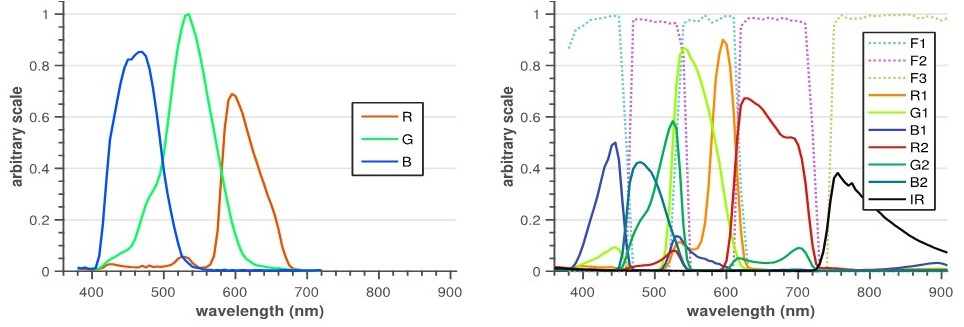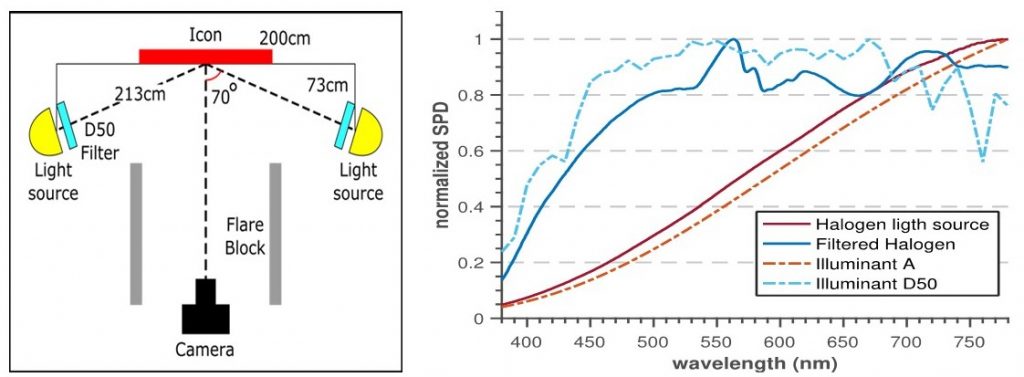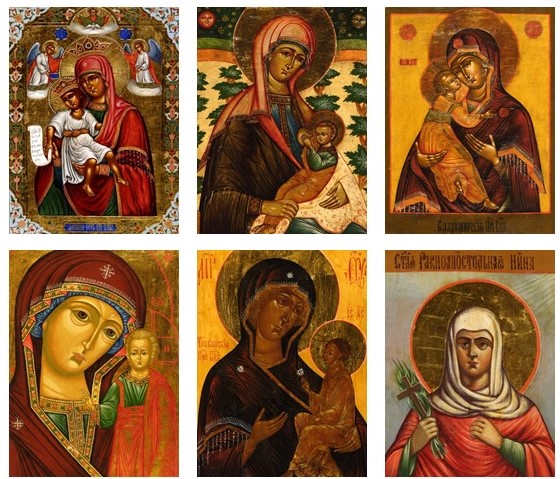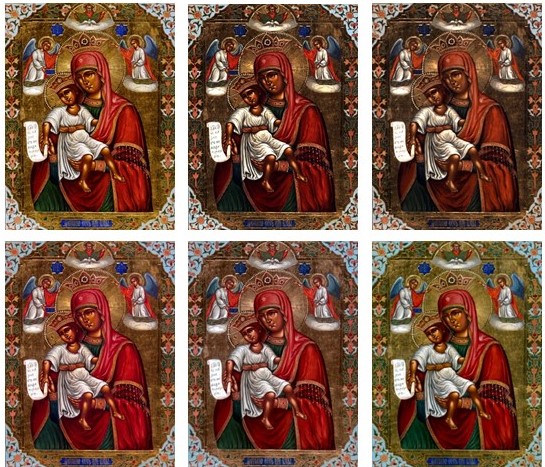SIDRI – Spectral Image Dataset of Religious Icons
SIDRI is a registered image database of icon paintings, captured with several cameras. The database is useful for spectral estimation studies, camera quality assessment, and analysis of the spatial-factors of the image-quality.
The icons
The icons belong to the theology department of the University of Eastern Finland. They are Russian Orthodox church icons from the late nineteenth to the early twentieth century. List 1 lists their names and physical dimensions. Figure 1 shows the icons and their relative sizes. According to their position in this figure, from left to right, we refer to them as Icon-1 to Icon-6 in the database.
List 1 The names, heights x widths, thicknesses, and mediums of the icons
- Dostino Jest, 310 x 240 mm, 18 mm thick, oil
- Imettävä Jumalan Äiti, 320 x 260 mm, 28 mm thick, tempera
- Vladimirin Jumalan Äiti, 355 x 285 mm, 30 mm thick, tempera
- Kazanin Jumalan Äiti, 330 x 280 mm, 23 mm thick, tempera
- Tihvinin Jumalan Äiti, 420 x 320 mm, 15 mm thick, tempera
- Pyhä Nina, 310 x 240 mm, 30 mm thick, tempera

The cameras
The SIDRI imaging campaign used four camera modalities to photograph the icons. Also, a previous set of measurements with a fifth camera was adopted and registered to the current measurements. The cameras were: an RGB camera, a seven-band multi-spectral beam-splitter (MSBS) camera, two liquid crystal tunable filter (LCTF) cameras in visible (VIS) and near infra-red (NIR) regions, and finally, a line-scanning hyperspectral camera that was used in the former measurements (Specim IMSpector-V10). List 2 lists the models, the lenses, and the type of charge-coupled-devices (CCD) of the cameras.
List 2 The camera modalities used for collecting SIDRI.
- RGB: Nikon D80, AF-S DX NIKKOR 18-135mm 1:3.5-5.6 G IF-ED lens, 12-bit, 3900×2611
- MSBS: FluxData FD-1665-MS7, Carl Zeiss Planar 1.4/50 ZF-IR lens, 12-bit, 1392×1040
- LCTF-VIS: Nuance N-MSI-420-10, AF Micro-Nikkor 60mm 1:2.8 D lens, 12-bit, 1392×1040
- LCTF-NIR: Nuance N-MSI-EX, AF Micro-Nikkor 60mm 1:2.8 D lens, 12-bit, 1392×1040
The spectral RGB camera had a Bayer color filter array that collected light in three wide-band ranges (see Figure 2.a). The MSBS camera had a trichroic prism to split the incoming light into three beams, and at each face of the prism one CCD collected the light. Two of the CCDs had RGB Bayer color filter arrays in front of them, and the third CCD was monochromatic. However, the prism had pass-band interference filters (F1 and F2) that modulated the sensitivity of the RGB channels so that each channel collects light in only one-half of its original sensitive region. The interference filter on the monochrome CCD (F3) blocked the light lower than 730nm. This combination provided a total of seven different channels; three from each RGB CCD, and one infra-red channel from the monochrome CCD. Figure 2.b shows the pass-band filters’ transmittance and the channels’ final sensitivities after being filtered. The sensitivities were measured with a monochromator and an integrating sphere.

The LCTF-VIS camera measures the light with narrow-band filters in the wavelength range of 400-720nm with 10nm sampling interval, that is 33 bands. The LCTF-NIR camera operated in 450-950nm range with 10nm sampling interval, providing 51 samples per pixel. Finally, the V10 camera captured the images in wavelength range 400-1000nm with 5nm intervals.
The setup
The icons’ surfaces are curved, varnished, and gilded. These factors increase the specular reflection component of the light, and also, increase the dynamic range of the scene. The imaging and illumination setup of Figure 3.a was used to shoot the icons with all the camera modalities in SIDRI database. Two halogen lamps were used to lit the icons from both sides, symmetrically. The halogen light sources were filtered with a CIE-A to CIE-D50 simulating filter in order to provide a spectrally flat light and achieving a consistent signal to noise ratio for all image channels. Figure 3.b shows the spectral power density of the light source.
For comparison purposes, a few other setups were also tested for the RGB camera. These setups include: the cross-polarizer setup, the 45-degrees angle light source setup, the close-range (one meter) soft-light setup, and the CIE-D65 filtered light source setup. These additional measurements are also registered and included in the database.

As mentioned before, the V10 camera measurements were adopted from a previous measuring attempt. These images were obtained under an overhead CIE-D65 soft-light at a 45-degree angle. To reduce the noise in these measurements we applied a HYSIME subspace noise removal method before the registration process.
Post-processing and registration
The standard color checker charts, the cameras’ dark-frame images, and a white reference object were also imaged besides the icons. These images were used for flat-field correction and calibration of the images. The cameras with color filter arrays, i.e., the RGB and the MSBS cameras, were demosaiced. The RGB images were demosaiced using a gradient-corrected interpolation, and the MSBS images were interpolated linearly. The multi-modal feature-based registration process was performed using the Scale-Invariant Feature Transform (SIFT) and a polynomial transformation model of third order. A iterative outlier removal method was used to remove the mismatching control points.
The dataset
A registered version of the SIDRI dataset is hereby available for download. This version is registered to the LCTF-VIS images (as the reference camera). The final images are set to a size of 640×480 pixels. Figure 4 shows the sRGB images of the icons (from the RGB camera) after the registration and cropping to a desired ROI-frame. All the images (from all five camera modalities) that are published below for download have the same image-size and ROI-frame.

For example, Figure 5 shows the images of Icon-1, from all the camera modalities. The colors are not the same on the display, because some of these images are sRGB values, and the sRGB simulated images are not from the same wavelength range. However, as they are registered, there is an accurate pixel-to-pixel correspondence among them.

Figure 6 shows the representative gamut of the SIDRI dataset in the CIE-Lab color space. This gamut is formed from about thirty-thousand samples that are sampled with a random uniform grid with average grid step of 1-dE in the CIE-Lab space. The CIE-Lab values are calculated from the LCTF-VIS images. The black dots represent the Munsell book of colors gamut, plotted here for comparison.

Dataset contents and download links
The registered version of dataset with size 540×480 pixels can be downloaded from here. The images are provided in TIFF-Stack Data Architecture as explained here and here. This format is a standard multi-layer TIFF file, thus it can be opened with typical image-viewer application. The first image-layer in each file is a pseudo-RGB representative of the image cube contents. Starting from the 2nd image-layer, each layer is a grayscale image that represents one channel. A utility m-file function is also provided, in order to easily access the image layers inside MATLAB environment. The complete dataset is about 1.7Gb in size. For fast access, the whole dataset is downloadable as a single ZIP file as well.
The image files are provided in six directories, one for each camera modality, and the sixth one for the JPEG images from the RGB camera. Each file-name has three parts: part one specifies the camera modality, part two specifies the imaging setup, and part three specifies the icon number.
The camera codes are:
- d80: Nikon D80 camera, processed RAW values
- jpg: Nikon D80 camera, processed JPEG values
- flux: 7-band MSBS FluxData camera
- vis: Nuance LCTF camera in Visible range
- nir: Nuance LCTF camera in Near-Infrared range
- line: Specim IMSpector-V10 hyperspectral camera
The imaging setup codes are:
- s12: The setup shown in Figure 3. This setup is the main setup that is used for all the cameras and all the icons. The rest of the setups are only tested with the Nikon D80 camera and only for Icons 2, 4, and 5
- d45: The light sources are positioned in a 45-degree angle
- d65: CIE-D65 simulator filters are used in front of the Halogen light sources instead of CIE-D50
- one: The light sources are positioned at one meter distance from the icons
- pol: Cross-polarizer filters are installed in front of the light sources (sheet polarizers) and the camera lens
Citing
For citing the database please use the following publication:
Mirhashemi, Arash. “Configuration and Registration of Multi-Camera Spectral Image Database of Icon Paintings.” Computation 7, no. 3 (2019): 47.
License
The SpecTex dataset is licensed under a Creative Commons Attribution-NonCommercial-ShareAlike 4.0 International License. It is free to publish research containing results derived from this database as long as the database is cited properly.
Contacts
For further questions or any issues regarding the SIDRI dataset please contact the Computational Spectral Imaging Research group, Professor Markku Hauta-Kasari, by email markku.hauta-kasari (at) uef.fi